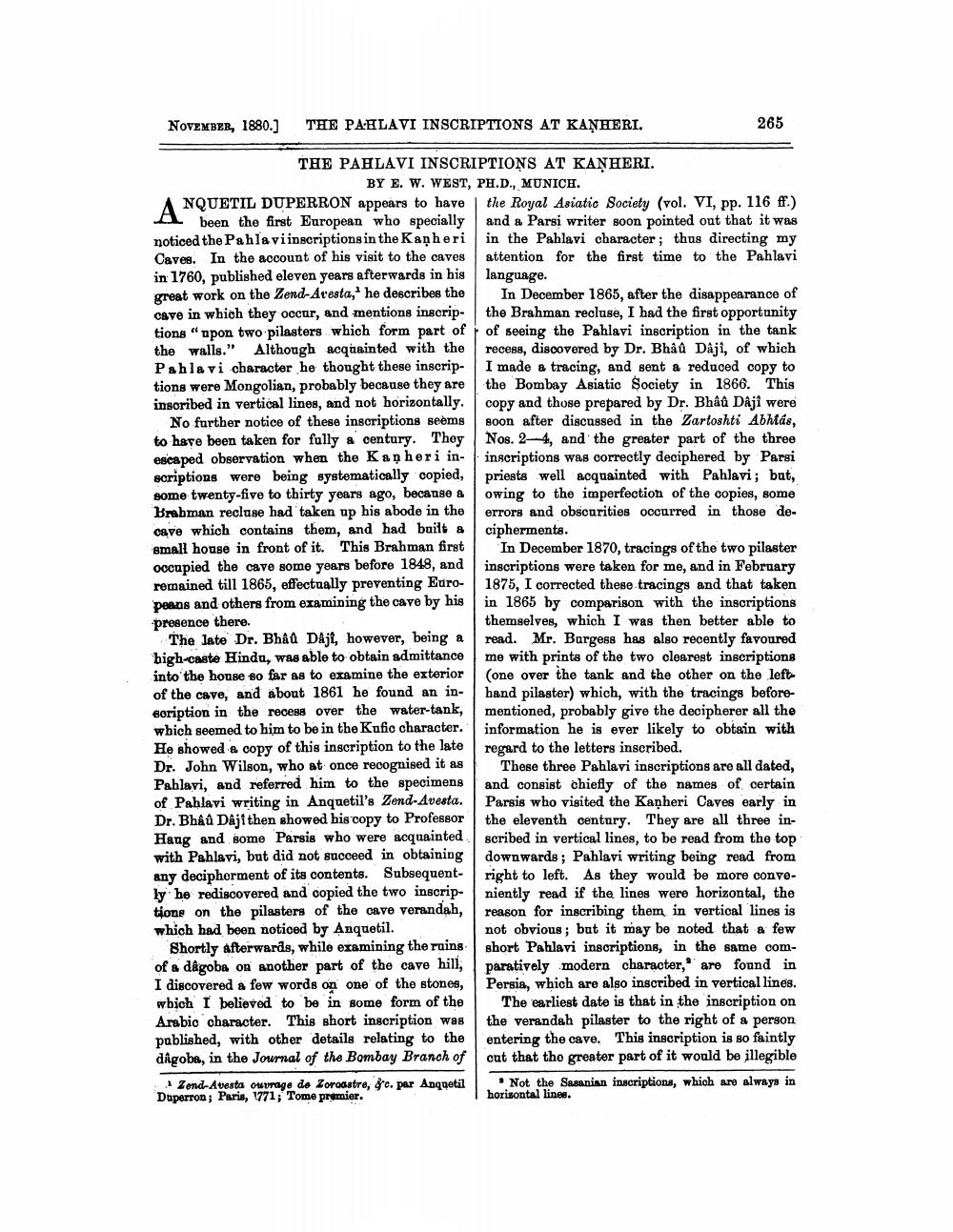________________
NOVEMBER, 1880.]
THE PAHLAVI INSCRIPTIONS AT KANHERI.
265
THE PAHLAVI INSCRIPTIONS AT KANHERI.
BY E. W. WEST, PH.D., MUNICH. ANQUETIL DUPERRON appears to have the Royal Asiatic Society (vol. VI, pp. 116 ff.)
been the first European who specially and a Parsi writer soon pointed out that it was noticed the Pahlavi inscriptions in the Kaņheri in the Pahlavi character; thus directing my Caves. In the account of his visit to the caves attention for the first time to the Pahlavi in 1760, published eleven years afterwards in his language. great work on the Zend-Avesta,' he describes the In December 1865, after the disappearance of cave in which they occur, and mentions inscrip- the Brahman recluse, I had the first opportunity tions " upon two pilasters which form part of of seeing the Pahlavi inscription in the tank the walls." Although acquainted with the recess, discovered by Dr. Bhâ û Dâji, of which Pahlavi character he thought these inscrip- I made a tracing, and sent a reduced copy to tions were Mongolian, probably because they are the Bombay Asiatic Society in 1866. This inscribed in vertical lines, and not horizontally, copy and those prepared by Dr. Bhâû Daji were
No further notice of these inscriptions seems soon after discussed in the Zartoshti Abhlás, to have been taken for fully a century. They Nos. 2-4, and the greater part of the three escaped observation when the Kanheri in- inscriptions was correctly deciphered by Parsi scriptions were being systematically copied, priests well acquainted with Pahlavi; but, some twenty-five to thirty years ago, because & owing to the imperfection of the copies, some Brabman recluse had taken up his abode in the errors and obscurities occurred in those decave which contains them, and had built a cipherments. amall house in front of it. This Brahman first In December 1870, tracings of the two pilaster occupied the cave some years before 1848, and inscriptions were taken for me, and in February remained till 1865, effectually preventing Euro- 1875, I corrected these tracings and that taken peans and others from examining the cave by his in 1865 by comparison with the inscriptions presence there.
themselves, which I was then better able to The late Dr. Bhâû Daji, however, being a read. Mr. Bargess has also recently favoured bigh-caste Hindu, was able to obtain admittance me with prints of the two clearest inscriptions into the house so far as to examine the exterior (one over the tank and the other on the left of the cave, and about 1861 he found an in- band pilaster) which, with the tracings beforesoription in the recess over the water tank, mentioned, probably give the decipherer all the which seemed to him to be in the Kufic character. information he is ever likely to obtain with He showed a copy of this inscription to the late regard to the letters inscribed. Dr. John Wilson, who at once recognised it as These three Pahlavi inscriptions are all dated, Pahlavi, and referred him to the specimens and consist chiefly of the names of certain of Pahlavi writing in Anquetil's Zend-Avesta. Parsis who visited the Kaņheri Caves early in Dr. Bhan Daji then showed his copy to Professor the eleventh century. They are all three inHang and some Parsis who were acquainted scribed in vertical lines, to be read from the top with Pahlavi, but did not succeed in obtaining downwards; Pahlavi writing being read from any decipherment of its contents. Subsequent- right to left. As they would be more convely he rediscovered and copied the two inscrip- niently read if the lines were horizontal, the tions on the pilasters of the cave verandah, reason for inscribing them in vertical lines is which had been noticed by Anquetil.
not obvious; but it may be noted that a few Shortly afterwards, while examining the ruins short Pahlavi inscriptions, in the same comof a dagoba on another part of the cave hill, paratively modern character, are found in I discovered a few words on one of the stones, Persia, which are also inscribed in vertical lines. wbich I believed to be in some form of the The earliest date is that in the inscription on Arabic character. This short inscription was the verandah pilaster to the right of a person published, with other details relating to the entering the cave. This inscription is so faintly dagoba, in the Journal of the Bombay Branch of cut that tho greater part of it would be illegible
Zond-Avesta ouvrage de Zoroastre, &c. par Anquetill Not the Sasanian inscriptions, which are always in Duperron ; Paris, 1971; Tome premier.
horisontal lines.




